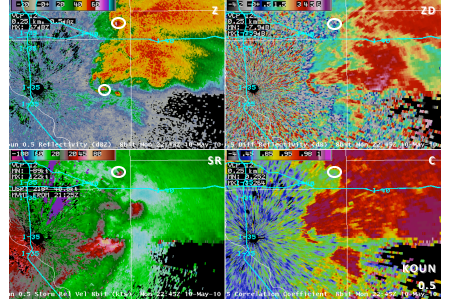
Field experiments and data collection are the lifeblood of the NOAA National Severe Storms Laboratory (NSSL) and when one experiment ends, another is often poised and ready to begin.
LIFT (Low-Level Internal Flows in Tornadoes) is the current field experiment NSSL scientists and partners (in this case, researchers from Texas Tech University) have undertaken. Beginning in mid-April of 2024, LIFT is anticipated to span multiple years, and aims to collect data in the “damage layer” of tornadoes (the lowest 20 meters near the ground), a region where data has not routinely been collected.
That might not seem intuitive, as the strength of a tornado is classified by its estimated wind speed and related damage (Enhanced Fujita Scale), however radar actually rarely sees this all-important damage layer. The angle of the radar beam typically measures higher up in the atmosphere due to the Earth’s curvature and the distance from the radar. As this field experiment is the first coordinated attempt at gathering information in the damage layer, LIFT is expected to be an exploratory, evolving effort, with a refinement to the approaches and observation techniques as researchers learn and gain experience.
One might ask why it is important to learn how strong winds are at the surface (they’re certainly strong enough to do all sorts of damage), but there are, in fact, a number of very important reasons.

First, classification of tornadoes is routinely undertaken after the storm by assessing damage. Fortunately however, a large number of tornadoes pass through open fields where the only structures might be vegetation or weakly built structures, limiting the value of damage assessment.
This was the case for a recent tornado (May 23, 2024) that struck southeast of Duke, Oklahoma, one of the early successes of LIFT. While the official rating after the damage assessment was an EF2 (since the only structure impacted by the tornado was a mobile home which was totally destroyed), peak observed velocities from mobile Doppler radar topped out at around 180 mph, which would mean the tornado contained winds often associated with tornadoes as strong as EF4.
Information gleaned from LIFT could also play a role in a better understanding and inference of the likely structure and wind distribution near the ground compared to characteristics of the radar-resolved vortex aloft. For instance, many tornado warnings are issued due to signatures identified in a DOPPLER radar image, but have no corresponding funnel that reaches the ground. It is hoped that knowledge obtained from these experiments will enable forecasters to better understand when the radar indicated vortex aloft is a threat to lives and property on the ground.
Finally, this information could improve our understanding of the tornado structure from parameters linked to tornado formation in forecast models, enabling the issuance of longer, more reliable and more focused watches.

So how will all of this data be collected? First and foremost will be safely of course, with staging attempts planned with a five to 10 minute cushion. In terms of data collection, available for the just completed first year of the experiment were two mobile radars from Texas Tech, which took observations from within a few miles of a few tornadoes. In addition, an NSSL mobile Doppler LIDAR, the first LIDAR to scan a tornado horizontally, sampled the near-ground adjacent flows underneath the mesocyclone as well as the outer region flows from the tornado. NSSL Mobile Mesonets were positioned to collect surface observations of variables such as temperature, pressure, and wind speed/direction from quite close to the tornado. Finally, UAS (Uncrewed Aircraft Systems) were used after the successful intercepts in the damage path to examine individual vegetation damage, with the goal of using common vegetation and soil damage to better estimate winds.
The first year of the LIFT experiment is now in the books, and it can only be described as a great success, with 11 deployments and numerous successful intercepts. An inordinate amount of data was collected, which will likely take years to fully examine and understand, but should help to provide some answers to the numerous questions NSSL scientists have asked.




